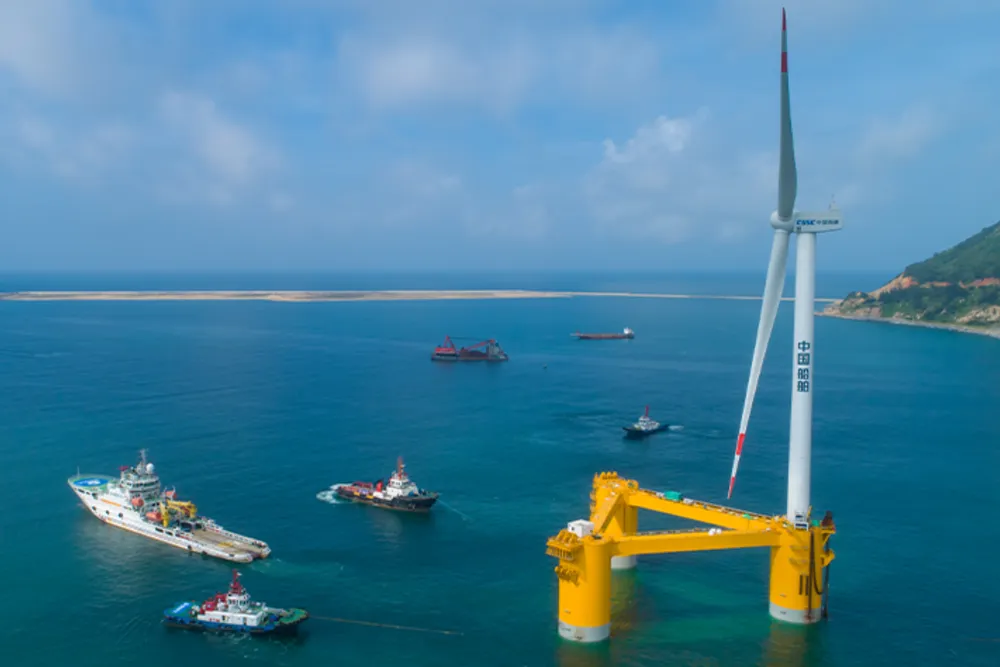Chinese floating wind takes shape as big names race to deploy
CNOOC and PowerChina among major players advancing large-scale floating technology

Beijing-based offshore oil and gas operator CNOOC aims to help China’s goal of becoming a leading deployer of floating wind technologies through development of a tension-leg platform (TLP) design for a demonstration project in the South China Sea.
The company plans to deploy a 16MW floating offshore wind turbine (FOWT) at the Lufeng oilfield cluster in the South China Sea using a Chinese version of a mooring system that is claimed to offer advantages in terms of stability in the water and reduced overall steel tonnage.
The project, which was outlined in an environmental impact assessment endorsed by China’s Ministry of Natural Resources, shows a TLP-mounted wind turbine located at a water depth of 136 metres, and connected to an offshore substation via a 3.8km subsea cable.
The project will be a step up from the earlier Haiyou Guanlan FOWT pilot that CNOOC commissioned in the South China Sea in 2023. This earlier project features a 7.25MW Mingyang turbine mounted on a semi-submersible hull at a water depth of 100 metres.
The Haiyou Guanlan FOWT supplies electricity to offshore oil and gas platforms in the Beibu Gulf, 136km from Wenchang, Hainan province, helping to reduce the greenhouse gas emissions caused by the production process there.
There are already indications that the turbine for the TLP-mounted pilot FOWT will also be supplied by Mingyang.
In October 2024, CNOC announced the selection of Mingyang in a tender for the development of a 15MW floating wind turbine prototype geared toward integrating deep-sea floating wind power with oil and gas production.
"This points strongly to Mingyang as the supplier of a turbine for the reported TLP project," noted Shashi Barla, a global offshore wind expert.
Pioneer projects
China already has a clutch of prototype and demonstrator FOWT projects either under development or up and running.
Here Mingyang was chosen to supply a 5.5MW turbine, mounted on a semi-submersible floating foundation and, subsequently, a 6.2MW model for one of the Xinghua Bay projects.
Shanghai Electric has been developing its own FOTW demonstrator in partnership with Longyuan Power Group, located off Nanri Island, Fujian province. This one features a semi-submersible floating platforms supporting a 4MW turbine, combined with a deep-sea aquaculture initiative.
China State Shipbuilding Corporation (CSSC) deployed a 6.2MW FOWT developed by its own CSSC Haizhuang unit at a 65-metre test location off Zhanjiang, Guangdong province.
In August 2024, the same company announced that it had completed installation of the world’s largest single-capacity offshore wind turbine" at a project in Hainan. A LinkedIn post described a power output of up to 20MW and a wind rotor diameter of 260-292 metres, using a modular design.
Scaling up
Floating offshore wind deployment is also accelerating through the 1GW Wanning project, under development by the Power Construction Corporation (PowerChina) conglomerate off South China's Hainan province.
The Wanning project, described as China’s first large-scale floating offshore wind project, is being built in phases and connected to the Chinese grid.
The first phase will deploy wind turbines with 16-17MW ofcapacity each, for a total capacity of 200MW.
A first contractual package covering 100MW of turbine capacity was awarded last year to a mix of Chinese turbine manufacturers, with CSSC Haizhuang and Dongfang supplying two turbines apiece and Mingyang and Shanghai Electric supplying one each.
"A tender for the next 100MW package is envisaged within the next few weeks, according to Barla, who reckons the EPC tender covering another 800MW of turbine capacity expected to launch soon afterwards.
"China is trying to accelerate the development of floating wind in the next four or five years because by the start of the next decade the majority of their offshore wind projects will be going into deeper waters,” Barla said
"The current phase is about testing prototypes to get some experience before developing those floating wind projects toward the end of the decade.”
Barla reckons China is on course to become the first country with large commercial scale FOW projects.
(Copyright)